Understanding the Importance of a Fly Fishing Backpack
Whether you are a seasoned angler or a beginner looking to discover the joys of fly fishing, having the right gear is crucial for a successful experience. One piece of equipment that stands out in this regard is the Fly fishing backpack. A well-designed backpack not only provides ample storage for your tackle and tools but also enhances your mobility and comfort as you traverse diverse fishing environments. In this article, we delve into why a fly fishing backpack is an essential companion for every angler and how to choose the right one for your needs.
Functionality: What Makes a Backpack Suitable for Fly Fishing
When selecting a backpack for fly fishing, the functionality greatly impacts your fishing experience. A suitable backpack should accommodate essential items such as rods, reels, fly boxes, and personal items while ensuring you have easy access to them. Functionality extends to how the backpack distributes weight across your body. Opt for a pack that offers adjustable straps that provide comfort during long outings. Additionally, consider features like hydration reservoirs and pockets designed for specific equipment to enhance your fishing productivity.
Key Features to Look for in a Fly Fishing Backpack
Quality backpacks encompass several key features that distinguish them from regular hiking bags. Here are some features to prioritize:
- Water Resistance or Waterproofing: Since fly fishing often involves wet environments, look for materials that either repel water or provide waterproof compartments to keep your gear dry.
- Multiple Compartments: An effective organization system is essential. A backpack with various compartments allows you to separate different types of gear, making them easier to locate.
- Comfortable Straps and Back Support: Prolonged wear can lead to discomfort if the backpack lacks proper support. Choose one with padded shoulder straps and back panels for maximum comfort and support.
- Lightweight Design: Especially if you plan to hike long distances while fishing, the weight of the backpack itself should not add to your burden.
- D-rings and Attachment Points: These provide spots to attach additional gear such as nets, water bottles, or even a small cooler, giving versatile options on the go.
How a Quality Backpack Enhances Your Fishing Experience
A quality fly fishing backpack can significantly enhance your overall fishing experience. By providing easy access to your gear, it allows for a seamless transition from one fishing spot to another. Moreover, a well-designed backpack that fits your body reduces fatigue, thus extending the time you can comfortably spend fishing. With less time fumbling for gear, you can focus on what truly matters: casting your line, observing the water, and enjoying the thrill of the catch.
Types of Fly Fishing Backpacks Available
When diving into the world of fly fishing backpacks, it’s important to recognize the variety available to meet different fishing styles and lengths of trips. Understanding these types can help you make an informed decision.
Daypacks vs. Multi-Day Backpacks
Daypacks are designed for short excursions, typically providing enough space for essentials needed for a single day on the water. These backpacks often prioritize lightweight materials and streamlined design. In contrast, multi-day backpacks cater to anglers who plan to be out on the water for extended periods. They come equipped with more storage space and can accommodate sleeping gear, clothing, and more extensive tackle systems, providing comfortable travel for longer expeditions.
Sling Packs: A Versatile Option for Anglers
Sling packs have gained popularity among anglers due to their versatility and ease of access. Unlike traditional backpacks, sling packs rest on one shoulder, allowing for quick transition from back to front, where all your gear is easily accessible. This type of pack is particularly advantageous for wading anglers who need to maneuver swiftly between casting angles or terrains.
Chest Packs: Convenience for Active Fishing
Chest packs are designed for maximum accessibility while providing the least interference in your fishing activities. They sit at the front of your body and keep essentials within easy reach, making them ideal for fly fishing. While their storage is usually limited, they compensate by offering versatility and comfort when casting, especially in fast-moving waters.
Essential Gear to Pack in Your Fly Fishing Backpack
Once you have selected your ideal fly fishing backpack, it’s crucial to know what to pack. An organized backpack ensures you have everything necessary for a successful fishing trip.
Fishing Tackle and Tools: What to Include
Start with the basics: your fishing tackle. Essential items include:
- Flies: Carry a variety of flies suitable for the waters you’ll be fishing in.
- Leader and Tippet: Ensure you have various weights and lengths for versatility.
- Tools: Pack forceps, scissors, a hook file, and other necessary tools to help manage tackle.
- First Aid Kit: Being prepared for injuries is essential when in remote areas, so include a small first aid kit.
- Personal Items: Sunscreen, snacks, and water are just as important as your fishing gear.
Waterproofing Your Backpack for Weather Preparedness
Preparing for inclement weather is vital when spending a day on the water. Invest in a waterproof backpack or a pack cover to shield your gear from moisture. Make sure to use waterproof bags to hold sensitive items like your wallet, cell phone, or extra clothing. A proactive approach in this area can lead to a more enjoyable fishing experience even during unexpected rainfalls.
Organizational Tips for Efficient Packing
To make the most of your fly fishing backpack, organization is key. Here are some tips to keep everything in order:
- Utilize Different Compartments: Use separate pockets for each category of gear to avoid confusion.
- Invest in Tackle Boxes: Small, stackable tackle boxes can keep your flies and tools neatly organized.
- Label Items: For complex setups, consider labeling each portion of your gear to streamline access.
- Pack Heavy Items Smartly: Keep heavier items close to your back to maintain a low center of gravity for better mobility.
Comparing Prices and Quality of Fly Fishing Backpacks
Investing in a backpack can vary significantly in terms of cost, and understanding how price relates to quality is crucial to making a prudent purchase.
How to Determine Value for Your Budget
As you explore various backpacks, take into account the features that are most important for your fishing style and frequency. While some packs may appear expensive, their durable materials and superior designs can provide long-term value. Weigh the cost against the frequency of use; if you fish often, consider a higher-priced investment in a quality backpack that will outperform cheaper alternatives.
Identifying Reliable Brands Without Brand References
While this article does not reference specific brands, it’s still vital to identify quality craftsmanship in any backpack you consider. Look for companies that provide warranties for their gear, utilize durable materials, and have positive reviews across multiple sources. Reliable brands tend to prioritize customer feedback and make necessary adjustments to their designs to meet the needs of anglers.
User Reviews: Learning from Other Anglers
User reviews can provide insight into how effective a backpack performs under various conditions. Reading through comments from other anglers can highlight features that excel or fall short in practical use. Pay attention to recurring themes in the reviews which will give you a clearer picture of а product’s characteristics before making a purchase.
Maintaining and Caring for Your Fly Fishing Backpack
Proper care of your fly fishing backpack can prolong its life and ensure it remains a reliable companion for years of fishing adventures.
Cleaning Tips to Ensure Longevity
Regular cleaning is essential, especially when exposing your backpack to dirt, mud, and saltwater. Most backpacks can be rinsed with water to remove dirt. For stubborn stains, use mild soap and a soft brush. Be sure to follow the manufacturer’s recommendations for washing and drying to avoid damaging any waterproof coatings.
Storage Best Practices When Not in Use
When your backpack is not in use, proper storage can prevent long-term damage. Store it in a cool, dry place, and avoid packing it tightly to help maintain its shape. Ensure that any zippers and compartments are clear of debris or moisture to protect against mold or degradation.
Repairing Common Issues: When to Seek Professional Help
Over time, wear and tear can take a toll on your gear. Common issues such as worn straps, tears, or broken zippers should be addressed promptly. You can often repair minor issues at home using fabric patches and sewing kits. However, for more significant repairs, seeking professional help from a specialist can ensure the durability of your backpack without compromising its integrity.
Choosing the right Fly fishing backpack involves understanding your fishing needs, prioritizing functionality, and considering quality features that enhance your experience on the water. By carefully selecting the right backpack, packing efficiently, and taking care of your gear, you can enhance your fly fishing adventures for years to come.

